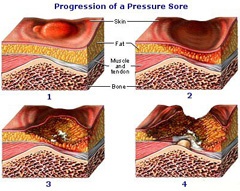According to the Consortium for Spinal Cord Medicine, “a pressure ulcer is a lesion/wound or injury, usually caused by unrelieved pressure that results in damage of underlying tissue.”
Knowing about the risk factors, prevention and stages of severity associated with pressure ulcers can better prepare you to deal with or reduce your chances of experiencing pressure ulcers while improving your quality of life.
Because anyone with a condition that impairs mobility or sensation is at an even greater risk for pressure ulcers, people who have experienced changes in the skin that follow Spinal Cord Injury (SCI) are are at especially high risk.

Pressure ulcers do not necessarily start on top of your skin. They may begin deep inside the tissues of your body (fascia) and work their way up to the outside of your skin. This makes it difficult to detect an ulcer early on. By the time your skin is discolored or has a open area (lesion) the tissue beneath is already damaged. That is why it is important to learn how to prevent pressure ulcers and how to check your body for signs of them.
Pressure ulcer severity is classified on a scale of I to IV.
Stage I: Considered mild with the least amount of damage. Skin is not broken (remains intact). You might find that:
– The skin is warmer or cooler to the touch.
– The tissue feels firmer or mushy as a result of fluid underneath (edema).
– The area may hurt or itch.
– The skin is a different color–pink or red in light skin; red, blue, or purple in darker skin.
Stage I pressure ulcers are often missed because:
– Changes in skin color can be hard to spot, especially in people with dark skin.
– Many people with SCI, their caregivers, and even some healthcare providers may be unfamiliar with the characteristics of a Stage I pressure ulcer.
Stage II: Still considered mild, the ulcer involves only the skin — the epidermis, the dermis, or both. The ulcer looks like a scrape, blister, or shallow crater.
Stage III: Now considered severe, the ulcer extends through both layers of skin and the subcutaneous tissue all the way to, but not completely through, the deep fascia. The ulcer looks like a deep crater with or without evidence of damage to neighboring tissue.
Stage IV: The most severe stage with the deepest levels of damage. The ulcer extends all the way from the surface of the skin through the fascia to involve muscle and bone and may extend to tendons and joints.
Information courtesy of the Consortium for Spinal Cord Medicine Consumer Guides.
Go to www.scicpg.org to download a free copy of Pressure Ulcers: What You Should Know.


